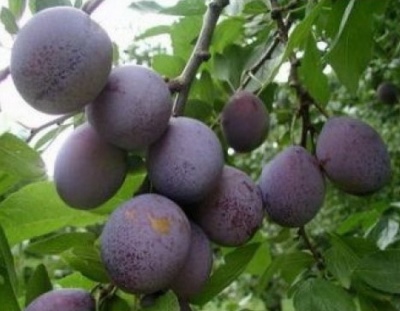
- Authors: G.V. Eremin, S.N. Zabrodin (Crimean Experimental Breeding Station of the All-Russian Research Institute of Plant Industry named after N.I. Vavilov)
- Appeared when crossing: Hungarian Caucasian х Kabardian early
- Growth type: vigorous
- Crown: round, medium density
- Fruit size: large
- Fruit weight, g: 30-40
- Fruit shape: wide oval
- Fruit color: purple
- Skin : with a thick waxy coating
- Pulp (consistency): dense
The blue bird is an old cultural symbol of success and happiness. But it is not enough for gardeners to limit themselves to symbols, they need an objective picture of what and how to grow. That is why it is important to understand the characteristics of the Blue Bird plum.
Breeding history
The plant was created at the All-Russian Research Institute of Plant Growing. More precisely, at his experimental station in the Crimea. The project was supervised by breeders Eremin and Zabrodina. To obtain the variety, we used Vengerka Caucasian and Kabardinskaya early, hybridizing them. The year of commissioning and inclusion in the State Register is 1997.
Description of the variety
The bluebird is considered a versatile plum crop. It has a strong trunk growth. The rounded crown reaches medium density. The branches are colored brownish brown. The foliage, green to saturation, has large plates with a matte sheen.
Fruit characteristics
Large drupes of the Bluebird weigh 30-40 g. In shape, they are similar to a wide oval. Other features:
violet color of the surface;
the peel covered with a waxy bloom;
good separation of the kernel from the pulp.
Taste qualities
The yellow flesh of the drupes is quite dense. It is distinguished by its expressive sweetness. According to unofficial data, the fruits of this variety are rather sweet and sour in taste. The overall tasting score is 4.6 points. The share of dry matter accounts for 15.6% of the total mass, while sugars are 10.8%, and the acid content is 0.7%.
Ripening and fruiting
Plum Blue bird has an average ripening period. Harvesting usually begins in mid-August. Fruiting regularly, without interruptions for individual years. It should be borne in mind that weather conditions and the quality of care can greatly affect the timing of a particular season.

Yield
The first fruits from the plum can be removed at the 5th or 6th year of development. Drupes will appear steadily. The harvest for 1 tree reaches 30-35 kg per season. Importantly, the harvested crop can be stored for a very long time.
Growing regions
The culture was zoned for the North Caucasus and the Lower Volga region. Therefore, it can be perfectly grown on the Black Sea and Caspian coasts, in the Krasnodar and Stavropol Territories. Perhaps in the Rostov region. Cultivation in more northern regions is at your own peril and risk.
Self-fertility and the need for pollinators
The variety is self-fertile. He has no need for pollinating plants. However, if they are, the prospects will be somewhat better.
Growing and care
The bluebird should be planted in well-lit areas. South and southwest orientations are best suited. It is unacceptable to choose places with stagnant water, including lowlands. This variety should not be planted on acidic soil. For irrigation, use settled water.
Trees should be watered at least 3 times during the season. Young plums require 6 liters of water, adult specimens - up to 10 liters. Irrigation before flowering and after harvesting is especially critical. Fertilizers are applied:
before flowering;
when the first fruits appear;
when the crop is actively ripening.
Top dressing and watering can be combined. Skeletal branches in the crown are shortened to 60 cm. Only young plants should be covered. Rodent protection is provided with a net or roofing felt. For the winter, trees must be hilled and protected with a 10-centimeter layer of humus.




Disease and pest resistance
Bluebird specific pests are not mentioned in the official description. It can be assumed that it is enough to dispense with general measures of protection against aggressive creatures, which are recommended for other drains. At the same time, the plant staunchly resists:
moniliosis;
polystygmosis;
clotterosporium disease.

Despite the fact that plum is considered more hardy than many fruit trees, it is not immune from diseases. It is attacked by viral, fungal and bacterial infections, and parasitic insects harm it. It is necessary to notice and recognize the signs of plum disease in time. They are easier to deal with and defeat early on. Well, in order to protect the garden tree from such a misfortune in the future, preventive procedures can be carried out.
Resistance to soil and climatic conditions
This plum is quite winter-resistant. But with the likelihood of severe cold weather, shelter is necessary. It is organized in the same way as for other fruit trees. In hot dry periods, it is advisable to intensify watering and mulch the land.

Review overview
This variety shows itself well. Even with long-term cultivation, the likelihood of disease is relatively low. With standard care, the tree responds with decent yields. The blue bird is successfully cultivated even in relatively cold regions. But at the same time, agricultural technology is observed as strictly as possible.


































































